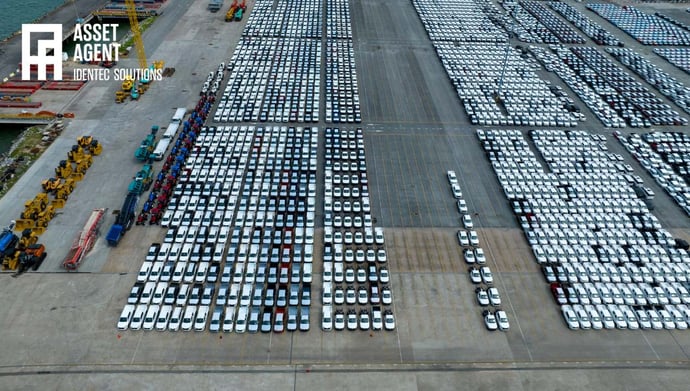The Growing Gaps in Car Terminal Operations
| Written by Mark Buzinkay
In 2023, global vehicle sales reached approximately 92.7 million units, reflecting a significant increase from the previous year. This surge underscores the immense volume of vehicles processed through car terminals worldwide. For instance, the Port of Vigo in Spain reported handling over 657,000 cars in 2024.
As vehicle throughput continues to escalate, car terminals are confronting mounting challenges related to capacity constraints, labour shortages, and complex inventory management.

No video selected
Select a video type in the sidebar.
What are the main challenges for car terminals today?
Port Congestion and Capacity Constraints
Supply chain disruptions have played a significant role in port congestion in the past. Events such as the COVID-19 pandemic and weather-related challenges have led to unpredictable shipping schedules and inconsistent vehicle arrivals. These disruptions cause a ripple effect, where delays in one part of the supply chain lead to congestion at ports awaiting delayed shipments.
However, port congestion has become a significant challenge in vehicle logistics primarily due to the increasing volume of new cars passing through ports and the limitations of available space. As global automotive production and exports continue to rise, many ports struggle to accommodate the sheer number of vehicles arriving for storage and onward distribution. The lack of adequate terminal space and infrastructure to handle these growing volumes leads to bottlenecks, delays, and higher costs for automakers and logistics providers.
A key issue is that many ports were not originally designed to handle the current scale of vehicle shipments. As production levels have grown and international trade has expanded, the demand for storage and processing areas at ports has exceeded capacity. With limited real estate available, vehicles often remain parked in terminals longer than anticipated, leading to overcrowding and inefficient space utilization. This situation is exacerbated when multiple shipments arrive simultaneously, forcing ports to temporarily store vehicles in overflow areas that may not be designed for such use.
The increasing size of vehicle carriers further adds to the challenge. Modern car carriers can transport thousands of vehicles in a single shipment, requiring large areas for unloading and temporary storage. When port infrastructure is unable to efficiently process these volumes, delays occur in clearing vehicles for onward transport. This congestion creates a ripple effect throughout the supply chain as automakers and dealers wait longer to receive their inventory.
Additionally, limited expansion opportunities at many major ports restrict the ability to accommodate growing vehicle volumes. In urban ports, land is often scarce and expensive, making large-scale expansion difficult. Some ports have attempted to optimize space through automation and vertical storage solutions, but these improvements take time and significant investment to implement.
As the demand for vehicle shipments continues to grow, finding solutions to space constraints at ports will be crucial. Without strategic investments in expanded infrastructure, smarter logistics management, and better space utilization strategies, vehicle congestion will remain a persistent issue, affecting the efficiency of the global automotive supply chain. (1)
Labour shortage
Additionally, labour shortages in car terminal operations have emerged as a complementary and significant challenge in the automotive logistics sector, impacting efficiency and throughput at ports worldwide. Car terminals rely on a steady workforce to handle critical tasks such as unloading, inspecting, and processing vehicles for storage and onward transportation. However, a decline in available labour and increasing vehicle volumes have led to severe operational bottlenecks.
One of the primary reasons for these shortages is the ageing workforce in port operations. Many experienced workers are retiring, and there is a lack of younger replacements entering the industry. The physically demanding nature of the job, combined with long and irregular shifts, makes it less attractive to new workers. Additionally, the global labour market has seen a shift in employment preferences, with more workers seeking jobs that offer remote or flexible working conditions, which are not feasible in car terminal operations.
The COVID-19 pandemic further intensified labor shortages as many workers left the industry during the shutdowns and did not return. This resulted in ports struggling to find enough personnel to move vehicles efficiently, increasing dwell times for new cars. Some major car terminals have reported backlogs due to insufficient manpower to process the large number of vehicles arriving daily.
The shortage of skilled drivers is another major issue affecting car terminals. Vehicles must be moved carefully from ships to storage areas and then onto transport trucks or railcars. A lack of trained personnel in these roles has caused delays, as ports are forced to operate at reduced capacity. This problem is compounded by stricter licensing and certification requirements, making it harder to hire and train new workers quickly. (2)
PDI Inspections and compliance documentation
Pre-delivery inspections (PDIs) are critical components in the automotive supply chain, ensuring that vehicles meet quality standards and regulatory compliance before reaching customers. However, the extensive nature of these inspections, coupled with the necessity for comprehensive compliance documentation, presents another significant challenge in vehicle logistics.
The PDI process involves meticulously examining each vehicle to identify and rectify any defects or issues that may have arisen during manufacturing or transit. This includes checking mechanical components, electrical systems, and cosmetic features to ensure the vehicle meets the manufacturer's specifications and safety standards. Given the complexity and increasing technological advancements in modern vehicles, these inspections have become more time-consuming and require specialized expertise. Manual inspection processes are particularly prone to variability and inconsistency, as different inspectors may interpret criteria differently, leading to non-uniform outcomes. This inconsistency can result in delays and increased operational costs.
In addition to the physical inspections, vehicles must adhere to many regulatory requirements before being legally operated. This necessitates preparing and verifying extensive compliance documentation, such as certificates of conformity, emissions reports, and safety certifications. The documentation process is further complicated by the fact that regulatory standards often vary between regions and countries, requiring logistics providers to navigate a complex landscape of compliance obligations. Ensuring that all necessary paperwork is accurately completed and submitted in a timely manner is essential to avoid legal repercussions and delivery delays (read more about roro cargo operations).
Lack of visibility
A lack of visibility exacerbates several other interrelated challenges in car logistics—onsite security, space storage, onward delivery, and complex inventory management. Collectively, these issues hinder operational efficiency and elevate costs within car terminal operations and the entire vehicle logistics chain.
Onsite Security
Transportation infrastructures, including vehicle storage facilities, are prime targets for theft and vandalism. The expansive nature of these sites often makes comprehensive monitoring difficult, allowing unauthorized access that can lead to cargo tampering and asset damage. The financial repercussions are significant, encompassing direct losses and operational delays. Implementing live video monitoring has been suggested as a solution to enhance real-time surveillance and immediate response capabilities, thereby bolstering security measures.
Space Storage
Efficient space utilization is critical in vehicle logistics. However, inadequate visibility into inventory levels and locations can result in either underutilization or overcrowding of storage areas. Such mismanagement not only escalates storage costs but also complicates the retrieval process, leading to delays in vehicle dispatch. A disjointed view of inventory often stems from the use of disparate tools and systems, which hampers the ability to maintain accurate records and optimize space.
Complex Inventory Management Due to Lack of Visibility
A fragmented approach to inventory tracking leads to inconsistencies between physical counts and digital records. This discrepancy can cause overstocking or stockouts, disrupting the balance required for efficient operations. In-transit vehicles may enter tracking dead zones, further obscuring their status and location. Such gaps in visibility impede timely decision-making and can halt production lines, especially in just-in-time manufacturing environments.

Change processes to easE pressing needs
Capacity constraints
Terminals must implement smarter space utilization strategies to mitigate capacity constraints. One approach is the adoption of vertical storage solutions, which allow for higher-density storage without expanding the terminal's footprint. However, this comes with a high upfront investment. Additionally, reconfiguring yard layouts to optimize vehicle movement can help maximize available space and reduce congestion.
Another key factor in addressing capacity issues is improving real-time inventory management. Many terminals still rely on outdated tracking methods, which lead to misplaced vehicles and inefficient use of space. Implementing RFID and GPS tracking systems enables terminals to monitor the exact location of each vehicle, reducing time spent searching for inventory and ensuring efficient allocation of storage areas.
In addition to physical and technological solutions, better coordination between port authorities, shipping lines, and land transport providers is essential. Ensuring a seamless flow of vehicles from terminals to carriers minimizes the time vehicles spend in storage, freeing up space for incoming shipments.
Labour shortage
Some car terminals have started to implement automation solutions, such as autonomous vehicle movers and digital tracking systems, to mitigate labour shortage challenges. However, these technologies require time to deploy and still rely on human oversight. Until a sustainable workforce strategy is in place, labour shortages will continue to challenge the efficiency of car terminal operations, slowing down the overall automotive supply chain.
PDI inspections and documentation:
The automotive industry is increasingly turning towards digitization and automation of the PDI and compliance processes to address the challenges of inspections and documentation. Implementing standardized digital checklists and procedures can reduce human error and promote uniformity across inspections. Automated PDI stations equipped with robotics and imaging technology can swiftly identify issues such as scratches, dents, or missing components, thereby reducing inspection times and enhancing accuracy. Moreover, digital platforms can streamline the management of compliance documentation, ensuring that all regulatory requirements are met efficiently.
Visibility
Addressing security, storage and inventory management challenges requires a holistic approach integrating advanced technologies and process improvements. Implementing end-to-end supply chain visibility tools can provide real-time tracking of vehicles, enhancing inventory accuracy and space utilization. For instance, affixing Bluetooth beacons to vehicles allows for continuous monitoring, reducing the risk of asset shrinkage and improving overall inventory management.
Moreover, adopting comprehensive security solutions that combine cutting-edge technology with trained security personnel can mitigate onsite security risks. Hybrid security models, which integrate live monitoring systems with physical patrols, offer a layered defence against unauthorized access and theft.
FAQ: Car Terminal Operations
What are car terminals, and what role do they play in vehicle logistics?
Car terminals are specialized port facilities designed for handling, storing, and distributing vehicles before they reach their final destination. They function as key hubs in the global automotive supply chain, facilitating the unloading of new vehicles from roll-on/roll-off (RoRo) vessels, conducting pre-delivery inspections (PDI), and organizing onward transport via road or rail (see also: RoRo car operations). These terminals help manage large vehicle volumes efficiently while ensuring compliance with regional import/export regulations.
What are the biggest challenges faced by car terminals today?
Car terminals face multiple challenges, including capacity constraints due to increasing vehicle volumes, labor shortages affecting loading and inspection processes, and supply chain disruptions that cause delays in vehicle movement. Additionally, managing vehicle inventory efficiently is difficult without real-time tracking systems, leading to congestion and misplaced units. Security risks such as theft and vandalism also pose concerns, necessitating advanced surveillance and access control systems.
How can technology improve car terminal efficiency?
Technology plays a critical role in optimizing car terminal operations. Automated vehicle tracking using RFID and GPS systems enhances inventory management and reduces delays. AI-powered scheduling helps improve berth and yard space utilization, minimizing congestion. Additionally, digital platforms enhance compliance documentation, improving overall logistics efficiency.
Takeaway
Optimizing vehicle inventory management in car terminals is a necessity and a feasible and highly beneficial approach to addressing industry challenges. The increasing volume of vehicle shipments, coupled with space limitations, labour shortages, and regulatory complexities, has placed immense pressure on terminal operations. However, solutions exist, and they involve a strategic combination of process optimization and technology-driven enhancements.
By refining storage utilization through restructured yard layouts and vertical storage solutions, car terminals can maximize their limited space, improving throughput and minimizing bottlenecks. Enhancing workforce efficiency with automation—such as autonomous vehicle movers and AI-assisted inspection systems—reduces reliance on labour while ensuring faster and more accurate processing. Moreover, digitizing inventory tracking with RFID, GPS, and real-time data platforms improves visibility across all operational stages, preventing vehicle misplacement and reducing unnecessary delays.
These advancements illustrate that modern vehicle logistics do not solely rely on infrastructure expansion but rather on smarter management strategies. The integration of technology with adapted operational processes offers a scalable and cost-effective solution to ongoing congestion and inefficiencies. In the following whitepaper, we explore in-depth how cutting-edge innovations and strategic adjustments can transform car terminal operations, making them more resilient, streamlined, and capable of meeting future demands.
Glossary
A Pre-Delivery Inspection (PDI) is a comprehensive assessment conducted by automotive dealers to ensure a new vehicle's optimal condition before handing it over to the customer. This process involves examining mechanical components, electrical systems, and cosmetic features to identify and rectify any defects or issues that may have arisen during manufacturing or transit. The PDI ensures the vehicle meets the manufacturer's specifications and safety standards, providing customers with a reliable and safe driving experience. (4)
Sources:
(1) https://www.automotivelogistics.media/automotive-logistics-and-supply-chain-europe-insights/battling-the-bottlenecks-in-european-vehicle-distribution/45412.article
(2) https://www.automotivelogistics.media/ports-and-processors/an-ongoing-crisis-for-terminal-throughput/42642.article
(3) https://www.gminsights.com/blogs/top-challenges-in-the-automotive-industry-pre-COVID
(4) https://www.carwow.co.uk/blog/what-is-a-pre-delivery-inspection

Author
Mark Buzinkay, Head of Marketing
Mark Buzinkay holds a PhD in Virtual Anthropology, a Master in Business Administration (Telecommunications Mgmt), a Master of Science in Information Management and a Master of Arts in History, Sociology and Philosophy. Mark spent most of his professional career developing and creating business ideas - from a marketing, organisational and process point of view. He is fascinated by the digital transformation of industries, especially manufacturing and logistics. Mark writes mainly about Industry 4.0, maritime logistics, process and change management, innovations onshore and offshore, and the digital transformation in general.
Related Articles
Related Product



